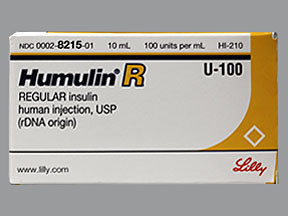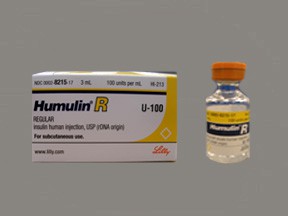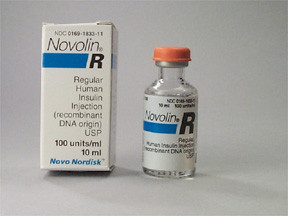INSULIN REGULAR HUMAN - INJECTION
PHONETIC PRONUNCIATION: (IN-su-lin)
COMMON BRAND NAME(S): Humulin R, Novolin R
GENERIC NAME(S): insulin regular, human
Uses
USES: Insulin regular is used with a proper diet and exercise program to control high blood sugar in people with diabetes. Controlling high blood sugar helps prevent kidney damage, blindness, nerve problems, loss of limbs, and sexual function problems. Proper control of diabetes may also lessen your risk of a heart attack or stroke. This man-made insulin product is the same as human insulin. It replaces the insulin that your body would normally make. It is a short-acting insulin. It works by helping blood sugar (glucose) get into cells so your body can use it for energy. This medication is usually used in combination with a medium- or long-acting insulin product. This medication may also be used alone or with other oral diabetes drugs (such as metformin).
How to use INSULIN REGULAR HUMAN - INJECTION
HOW TO USE: Read the Patient Information Leaflet provided by your pharmacist before you start using this medication and each time you get a refill. If you have any questions, ask your doctor, diabetes educator, or pharmacist. Learn all preparation and usage instructions from your health care professional and the product package. Before using, check this product visually for particles or discoloration. If either is present, do not use the insulin. Insulin regular should be clear and colorless. Before injecting each dose, clean the injection site with rubbing alcohol. Change the injection site each time to lessen injury under the skin and to avoid developing problems under the skin (lipodystrophy). Insulin regular may be injected in the stomach area, the thigh, the buttocks, or the back of the upper arm. Do not inject into a vein or muscle because very low blood sugar (hypoglycemia) may occur. Do not rub the area after the injection. Do not inject into skin that is red, swollen, or itchy. Do not inject cold insulin because this can be painful. The insulin container you are currently using can be kept at room temperature. Inject this medication under the skin as directed by your doctor, usually 30 minutes before meals. Because this insulin is fast-acting, not eating right after a dose of this insulin may lead to low blood sugar (hypoglycemia). Giving insulin regular into a vein should only be done by a health care professional. Very low blood sugar may result. Do not use insulin regular in an insulin pump. This product may be mixed only with certain other insulin products such as NPH insulin. Always draw the insulin regular into the syringe first, then follow with the longer-acting insulin. Never inject a mixture of different insulins into a vein. Consult your health care professional about which products may be mixed, the proper method for mixing insulin, and the proper way to inject mixtures of insulin. Do not change brands or types of insulin without directions on how to do so from your doctor. Do not share your pen device with another person, even if the needle is changed. You may give other people a serious infection, or get a serious infection from them. Learn how to store and discard medical supplies safely. The dosage is based on your medical condition and response to treatment. Measure each dose very carefully because even small changes in the amount of insulin may have a large effect on your blood sugar. Check your blood sugar regularly as directed by your doctor. Keep track of your results and share them with your doctor. This is very important in order to determine the correct insulin dose. Use this medication regularly to get the most benefit from it. To help you remember, use it at the same times each day. Tell your doctor if your condition does not improve or if it worsens (your blood sugar is too high or too low).
Side Effects
Precautions
Interactions
Overdose
Images
Reviews
Faq for INSULIN REGULAR HUMAN - INJECTION
Insulin Regular Human is a hormone used to control blood sugar levels in people with diabetes. It works by helping glucose (sugar) enter the cells of the body, where it is used for energy.
Insulin Regular Human is typically injected subcutaneously (under the skin) using a syringe, insulin pen, or insulin pump. It should be injected into the fatty tissue just below the skin, usually in the abdomen or thigh.
The dosage of Insulin Regular Human varies for each individual and is determined by factors such as blood sugar levels, diet, exercise, and other medications. It is important to follow the instructions provided by your healthcare provider.
The timing of insulin injections can vary depending on individual needs. It is generally recommended to take Insulin Regular Human 30 minutes before a meal to allow it to start working before the rise in blood sugar caused by eating.
Common side effects of Insulin Regular Human include hypoglycemia (low blood sugar), allergic reactions at the injection site, weight gain, and lipodystrophy (thickening or thinning of the fat under the skin at the injection site). It is important to discuss any concerns or potential side effects with your healthcare provider.
Yes, Insulin Regular Human can be mixed with certain other types of insulin, such as NPH insulin, as prescribed by your healthcare provider. It is important to follow the specific instructions for mixing provided by your pharmacist or healthcare provider.
If you miss a dose of Insulin Regular Human, take it as soon as you remember. However, do not take a double dose to make up for a missed dose. It is important to consult your healthcare provider for guidance on managing missed doses.
Reusing insulin needles is not recommended, as it increases the risk of infection, pain, and difficulty with injection. It is generally recommended to use a new needle for each injection to maintain hygiene and reduce the risk of complications.
Insulin Regular Human should be stored in the refrigerator between 36°F and 46°F (2°C and 8°C). It should not be frozen or exposed to extreme temperatures. Once opened, it can be stored at room temperature (below 86°F or 30°C) for up to 28 days.
Disclaimer
IMPORTANT: HOW TO USE THIS INFORMATION: This is a summary and does NOT have all possible information about this product. This information does not assure that this product is safe, effective, or appropriate for you. This information is not individual medical advice and does not substitute for the advice of your health care professional. Always ask your health care professional for complete information about this product and your specific health needs.




No Reviews Yet